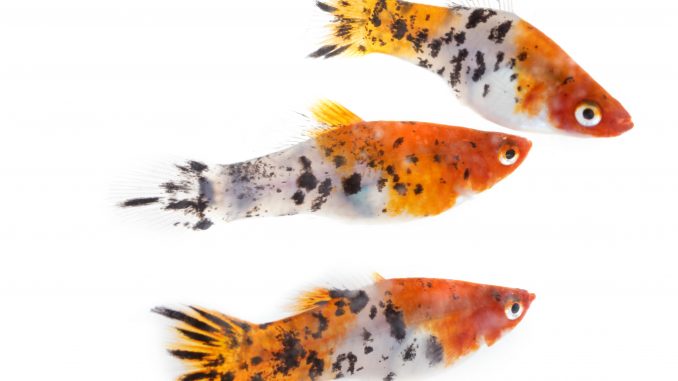
The livebearer is a freshwater fish of the family Poeciliidae. Livebearers are fish that carry eggs inside their bodies and give birth to live, free-swimming fry. Mollies, swordtails, guppies, and platies are examples of livebearing fish.
Livebearers are popular among aquarists who want to breed their fish. These fish are better for breeding because they give birth to live fish that are hardier and easier to look after compared to fry hatched outside a fish’s body.
TABLE OF CONTENTS
Livebearers Facts & Overview
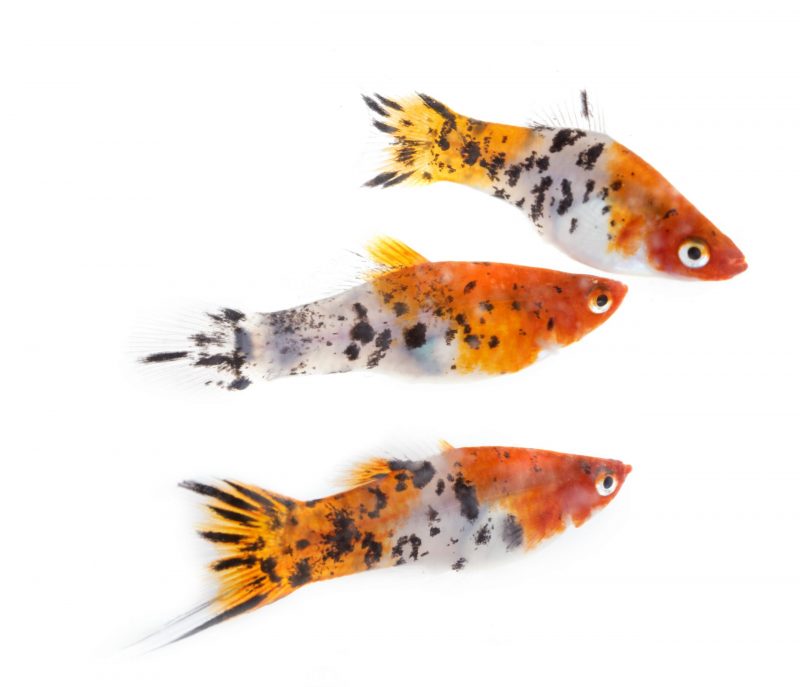
| Scientific name: | Depends on the fish species |
| Common names: | Livebearer, livebearing fish |
| Distribution: | Most common in the Southern United States and Central America |
| Size: | 2–6 inches |
| Life expectancy: | 3–7 years |
| Color: | Various colors |
| Diet: | Omnivore |
| Temperament: | Peaceful |
| Minimum tank size: | 10–30 gallons |
| Temperature: | 68–82°F (23–28°C) |
| pH: | 7.0–8.4 |
| Hardness: | 12–30 dGH |
| Care level: | Easy |
| Breeding: | Livebearing |
Origin
Livebearer fish species are commonly found in the Southern United States and Central America, including Mexico. They are common in the wild, and some livebearers, like guppies, are now found all over the world.
These fish prefer slow-flowing freshwater habitats such as streams and small pools of water.
Adult Size & Lifespan
Livebearers differ in size. Some livebearing fish reach three inches in length, while others grow to five or six inches.
Some female livebearer fish, such as female guppies, grow around one inch longer than males, and females are rounder than males when viewed from above.
The average lifespan of a livebearer is 3–7 years.
Availability
Livebearers are common, popular fish that are found in most pet stores. The cost of a livebearer is $2–$6 per fish, depending on the uniqueness of the fish’s colors and markings.
Most livebearers aren’t schooling fish, but if you’re buying the fish for breeding purposes, you should buy at least three fish (one male and two females), bringing the total average cost up to $6–$18.
Reputable online stores like LiveAquaria and Imperial Tropicals sell a range of livebearing fish, including mollies, platies, guppies, swordtails, and Endler’s livebearers.
Appearance & Behavior
Livebearers are found in a range of colors, patterns, and sizes. They are typically peaceful, sociable fish with easygoing personalities.
Colors, Patterns, Fins, and Sex Differences
The appearance of a livebearer depends on the fish species:
- Mollies have flat, rectangular bodies. Male mollies are torpedo-shaped, while females have wide tail ends. Black mollies have all-black bodies, while sailfin mollies have prominent dorsal fins and come in colors including yellow, orange, silver, black, and white
- Platies have thick bodies that taper down towards their tails, pointed noses, and large eyes. Platies come in a variety of colors, including black, blue, green, yellow, red, and brown. Female platies have fan-shaped anal fins, while male platies have long, flat, pointed anal fins.
- Guppies have small, slim bodies ending in large, fan-like tails, in colors including silver, blue, pink, orange, yellow, purple, and red. There are lots of different guppy tail shapes, including triangle tails, veil tails, round tails, halfmoon tails, needle tails, and fan tails. Female guppies have bigger, rounder bodies than males.
- Swordtails are slim, elongated fish. Males have an elongated lower lobe resembling a sword on their caudal fins, while females have round bellies and no elongated fins. Swordtails are red, yellow, and black, with patterns of stripes and bars.
- Endler’s livebearers share the same genetic makeup as common guppies. The fish are small and elongated, and the females have silver or gray coloring, while the males are found in fluorescent colors including yellow, green, blue, purple, red, and orange.
Typical Behavior
Livebearers are calm, peaceful fish that are compatible with most other fish in a community aquarium. Male livebearers are known for being competitive and aggressive towards one another when there are too many males compared to females in the tank.
Most livebearers are active fish that swim quickly around the middle of the tank. These fish prefer to swim in groups, and enjoy exploring and resting in caves and behind plants.
They are known to jump out of the water when they feel threatened.
Livebearer Care & Tank Requirements
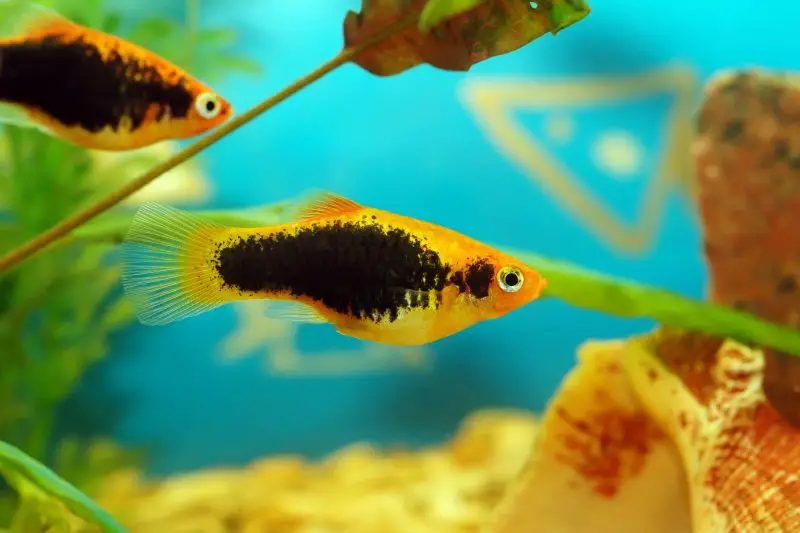
Livebearers are easy to care for. These hardy fish get on well with other fish and are adaptable to a range of water conditions, as long as these conditions remain consistent.
Provide a clean, freshwater tank environment, and feed the fish an omnivorous diet.
Habitat and Tank Requirements
The natural habitat of livebearers is slow-flowing, loosely vegetated rivers, streams, and lakes with moderately hard water with a temperature range between 68–82°F. Mimic this environment with a freshwater, planted tank to ensure the fish thrive in captivity.
Livebearers need a tank size of at least 10 gallons to give them plenty of space to explore and prevent stress from overcrowding. For groups of five or more, a 20–30-gallon tank provides open room, areas for territories, and hidden spots for breeding.
Sand is the best substrate for a planted livebearer tank. These fish don’t dig in the substrate, so the type of substrate is more important for plant growth than for pleasing the fish.
Caves, rocks, and hollow decorations replicate the livebearer’s natural environment and provide a place for the females to retreat to if they’re being hassled by the males. Good plants for a livebearer’s tank are anubias and Java fern.
Livebearers are used to brackish environments, so you should mimic this by adding a tablespoon of aquarium salt for every five gallons of water.
Tank Conditions
The ideal tank conditions for livebearers are:
| Water type: | Slightly hard, slow-flowing freshwater |
| Tank size: | Minimum 10 gallons, and at least 20 gallons for groups of five fish or more |
| Water temperature: | 68–82°F |
| Substrate: | Fine layer of sand |
| Tank setup: | Hollow decorations, plants, rocks, caves |
| Acidity: | 7.0–8.4 pH |
| Water hardness: | 12–30 dGH |
| Filter: | Yes. Use a good filter to keep the tank clean and provide a moderate current |
| Bubbler: | Yes. A bubbler cleans and oxygenates the water, allowing livebearers to thrive |
| Lighting: | Yes. The fish need at least 6–8 hours of light to mimic their natural day-to-night cycle |
| Water heater: | Yes, to maintain consistent warm water temperatures |
Livebearers are adaptable to a range of water parameters, but maintaining consistent temperatures and keeping the tank clean is essential to prevent stress and disease in the fish.
Disease
As long as livebearers are kept in clean, spacious tanks, the risk of disease is minimal. Some common health conditions affecting livebearers are:
Ich
Ich is a freshwater disease caused by the parasite Ichthyophthirius multifiliis. This parasite is carried into tanks by other fish, live foods, and plants, and causes white, salt-sprinkle spots on the fish’s body, fins, and tail. Fish with Ich are lethargic and exhibit flashing (rubbing against rough surfaces).
Treat Ich by quarantining affected fish in a separate tank with a water temperature of about 86°F to speed up the parasite’s life cycle.
Fin Rot
Fin rot is a bacterial infection that usually occurs in fish that are housed in inconsistent water conditions. The disease causes the edges of the fins to become inflamed, frayed, and blackened or brown. Clean the tank and carry out 20–50% water changes every day for up to two weeks to eliminate the bacteria responsible for fin rot.
Ask your veterinarian about antibiotic treatments if the fish’s symptoms don’t improve.
Velvet
Velvet is caused by a parasite known as Oodinium, which burrows beneath the top surface of the fish’s skin and produces rust-like, golden cysts. Darting around the tank, lethargy, and flashing are signs of velvet.
To treat velvet, add copper sulfate, formalin, or acriflavine to the tank, as advised by your veterinarian, and dim the lights in the tank to kill the light-dependent parasite.
Dropsy
Dropsy is a symptom, rather than a disease, indicating that the fish has a bacterial infection. Fish with dropsy appear bloated and lethargic, with scales that stick out more than usual. Rapid breathing and loss of appetite are other signs of dropsy.
Ask your veterinarian for a suitable antibacterial medication to treat your fish’s symptoms, and add ⅛ teaspoon of Epsom salt to every five gallons of water until the symptoms subside.
Tank Mates
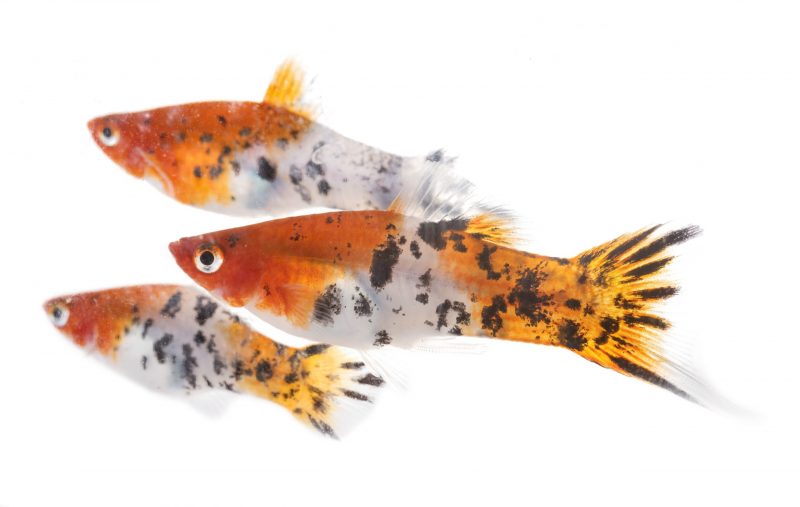
Livebearers get along well with most other fish, but they shouldn’t be housed with feisty, large fish like red tail sharks, tiger barbs, cichlids, and aggressive tetras.
Good tank mates for livebearers include:
- Other livebearers (mollies, platies, swordtails, guppies, and Endler’s livebearers can all live together)
- Corydoras
- Gouramis
- Angelfish
- Peaceful tetras
- Rasboras
Good non-fish tank mates for livebearers include:
- Ghost shrimp
- African dwarf frogs
- Freshwater snails
Diet and Feeding
In the wild, livebearers eat plant matter, small invertebrates, and algae. Replicate the livebearer’s varied diet in captivity with a combination of fish flakes, live foods, and plant foods.
The main bulk of the livebearer’s diet should be high-quality, vitamin-enriched fish flakes. Blanched spinach, lettuce, algae wafers, and cucumber are good plant foods for these fish. Live or frozen shrimp and bloodworms are great protein sources.
Feed livebearers a pinch of food twice or three times per day, providing enough food for the fish to eat in less than two minutes. Remove uneaten food immediately after feeding to maintain tank cleanliness.
Breeding
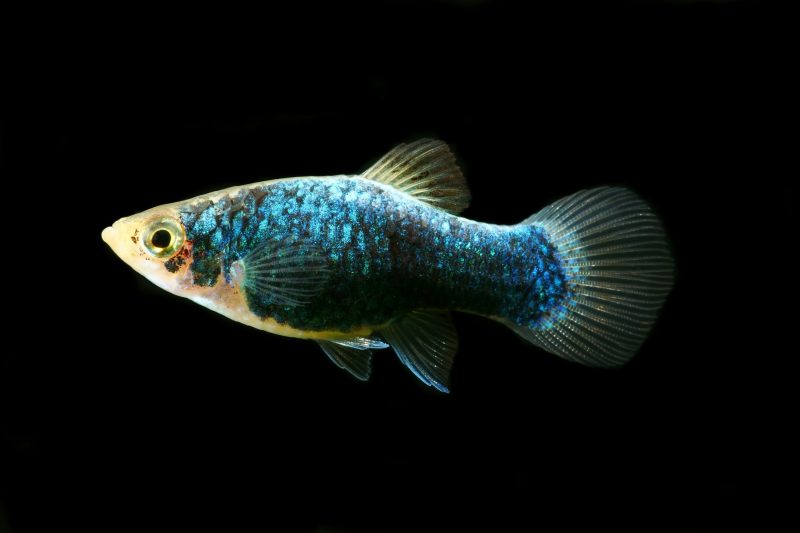
Livebearers are easy to breed. In many cases, the fish breed without prompting, and don’t require their own special breeding conditions. Livebearers reach sexual maturity between two and four months old.
To breed livebearers, follow these steps:
- Ensure there is a good ratio of males to females in the tank. There should be double the number of females to males.
- The males should begin to chase the females around the tank and flare their fins to show their interest in mating.
- The couples will breed in caves or behind plants.
- Observe the females every day, looking for a rounder-than-usual belly with a black spot, which indicates pregnancy.
- Move the pregnant females to a separate 20-gallon breeding tank with a heater, a water filter, and floating plants. The females will give birth to free-swimming fry after about four weeks.
- To prevent the fry from being eaten by the females, return the females back to the home tank and rear the fry in the breeding tank until they’re at least one inch in size.
- Feed the fry baby fish food or baby brine shrimp and perform two to three water changes per week.
Should You Get a Livebearer for Your Aquarium?
You should get a livebearer if you’re an aquarium enthusiast who’s looking to breed fish for the first time. These fish are peaceful, sociable fish, making them good additions to a community tank containing other laid-back fish species.
Don’t get a livebearer if your tank contains large or aggressive fish, or if you don’t have enough tank space to house a group of livebearers. These fish are fun, active fish with big personalities, providing entertainment and adding a burst of color to your tank.

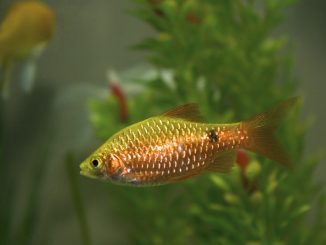
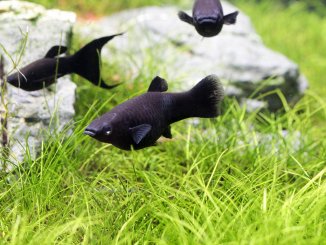
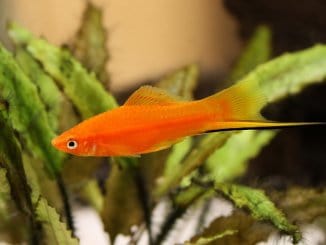
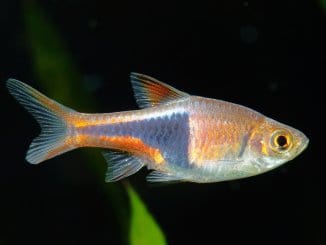
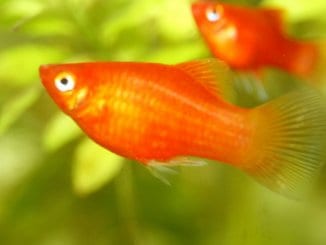
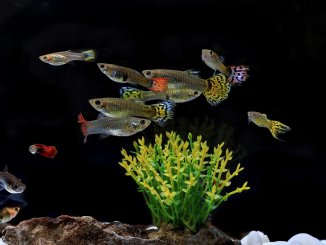
Can you mix some egg bearing dish with live bearers and what would the ph be if that is possible?